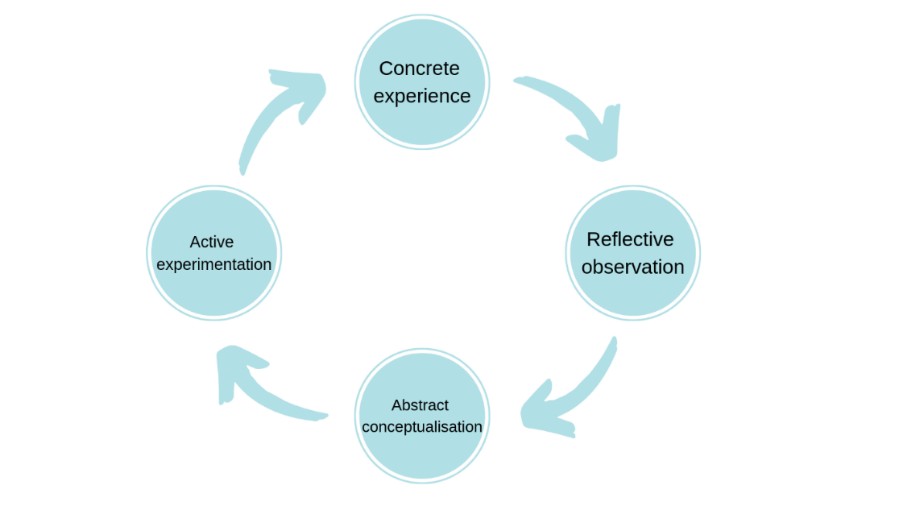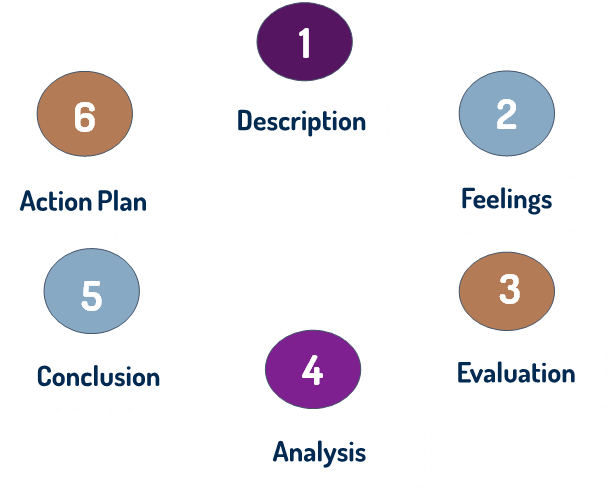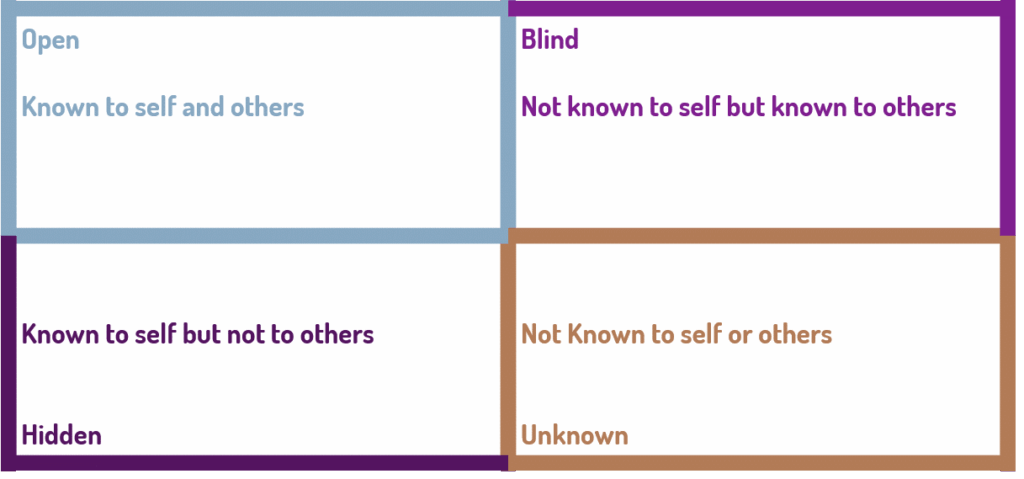Introduction:
Here at Get Up and Co., we appreciate and understand the importance of reflective practice for personal and professional development.
Have you ever wondered how something happens and questioned why?
Often, you will instantly know the answer, how to respond, and how to deal with the situation, allowing you to move on. This is not always a conscious process.
However, there are times when taking a step back and thinking about what has happened will lead to a clearer, more positive response to how you deal with a certain situation in the future. This is a conscious process known as Reflective Practice.
As the IQA for Get Up and Co., I consistently use reflective practice to ensure that all learners’ evidence is fairly assessed, ensuring that it is valid, authentic, current, sufficient, and reliable. In addition to reflecting as individuals, at Get Up and Co., we regularly hold team and standardisation meetings. This ensures that all assessments are fair and that we are all working towards the same goal. Annually, the team meets with the EQA of NOCN to ensure that all our practices align with NOCN’s policies and procedures.
Starting Out: My introduction to Reflection
I was first introduced to reflective practice whilst carrying out my DipHE JNC qualification, where I had a module on reflective practice. I was aware of what reflective practice was; however, following the lectures and assignments for the module, my mind was opened to reflective practice in a way that made me look at myself, my youth work practice, how my colleagues practiced, and to be more observant whilst delivery was taking place.
Finding an opportunity to reflect was not always easy; however, I found driving home from university was good reflective time. The journey was about an hour, and it gave me the space to think about the day, what I had learnt, and how observation and listening were really important to ensure I understood the bigger picture. It also made me think about my way of thinking, what my boundaries were, what my values were, whether I was being non-judgmental, and how I communicated with others.
This is a form of Self Reflection.
Different forms of reflective practice (Self, Group and Peer):
Self-Reflection
What is self-reflection? It is a process used to look at your thoughts, feelings, and how you behave.
As part of the university’s coursework, I completed 30 reflective practice journals, that’s right, 30, looking at the following:
- A critical incident (imagine taking a photo of a certain incident that happened during the youth work delivery)
- Analysing how people reacted to the incident
- Considering how it made people feel
- Exploring how it was linked to theory
- Reflecting on what would need to change or be done differently in the future
One of the reflective journals I wrote explored an incident that occurred at university within the courses scheduled on Tuesday afternoons, the professional development group (PDG). The form I belonged to regularly participated, and it was the last session of the day.
The idea of the PDG was to discuss relevant topics to youth work delivery, current news, and also to seek/provide support to each other regarding our youth work delivery. It taught us how to discuss different points of view in a non-confrontational way and how to manage confrontational challenges of views.
The discussion topic was raised by one of the students. Would you support a young person who had seriously harmed, assaulted or abused a child? The immediate reaction from some members of the group was ‘no.’ Others said they would have to think about this and seek support from their manager. One person stated that they felt it would be beyond their capability as a youth worker and that the young person should be referred to specialist support.
It was clear that several people felt uncomfortable about this, and they were not sure whether they would be able to provide support. However, one member of the group, who had posed the question, was adamant that they would support and felt very strongly about this. They even went on to state that they would support the young person even if it had been their daughter/son who had been abused. Several members of the group disagreed with this person and stated so; others just sat in silence. It was evident how people were feeling by their body language and facial expressions. People were shuffling in their seats, avoiding eye contact, and were generally uncomfortable.
What followed was a heated discussion for around an hour. At the end of the session, everyone was feeling some way, and I remember, whilst driving home, thinking what on earth just happened? It took a while for me to really think about the incident. I had made notes during the session, and these helped with the reflective recording. The notes included people’s reactions, body language, and what they thought, and having these notes ensured I could remember the incident clearly. I also remember thinking a lot about this the following week. I spoke with two of the other students in the course, also from the same local authority, to seek their views, and I was wondering how the next session was going to play out. I was feeling slightly uncomfortable about the next session, but also intrigued as to how it would go. I also wondered if anyone else had decided to use this as one of their reflective recordings for the coursework. One colleague with whom I got on well did use this situation as well, I found out at a later date.
Linking this to theory and good practice was quite a challenge, but after searching through books, links were found around boundaries, relationships, group work, and the role of a youth worker. My reflections were that I felt this young person would need specialist support from professionals who worked in this field, and that the young person should be signposted to these. I also understood that the young person, if they did access a youth project, would not be able to attend due to the nature of the situation, also that once it became a police matter, it could not be spoken about with the young person due to the ongoing investigation. This would make it hard to support them. I also realised that if this occurred within a youth project where I was working, then speaking to my line manager would be a must due to safeguarding concerns. However, all young people deserve support; it is just knowing who the right support agencies are.
You might have noticed I used self-reflection as a tool to understand a situation that took place in a group reflection space, and I sought support from peers to help reflect and better understand the situation.
Group and Peer reflection
As you can see from the example above, reflective practice is not always an individual thing. Reflection can take place in a group and with peers.
Think about how evaluations are completed at the end of a youth work session. Evaluating the session is key to future delivery, assessing young people’s needs, and allowing everyone’s voices to be heard. It also permits space to make positive choices and changes to the teams and your delivery.
In a youth work setting where good reflective practice takes place, you will notice the supervisor will also practice reflective practice, ensuring that reflective practice continues throughout the team, from the manager down to part-time staff and volunteers.
Reflective practice should be part of the supervision process agenda. The theories below provide ideas on how to develop your reflective practice procedures, if you are looking to embed a new reflective practice framework or develop one you already have in place.
Reflective practice theories:
Reflective practice learning theories enable individuals/groups to reflect on real-life experiences that have taken place. Theory helps you see that experience, reflection, learning, and action all link together, and encourages you to go deeper by thinking about feelings, evaluation, and what you would do differently next time.
1. Kolb

Several theories go through the process of reflective practice, one of which is Kolb’s Experiential Learning Cycle (1984). I used this throughout my Youth Work career and shared this theory with part-time youth workers; also, it was used to plan all youth work sessions, activities, and projects alongside the NAOMIE planning process.
2. Gibbs Reflective Cycle
Gibbs uses the same approach as Kolb but has expanded on the different stages, having six in total.
The tool provides clear guidelines to follow and touches on all aspects from start to finish, enabling clearer thinking of the process and producing actions to follow to make positive changes.

3. 360 Feedback
Is a structured way of receiving feedback on performance, behaviours, and assessing how competent a person may be.
360 feedback is a very good way of receiving feedback on your overall performance from colleagues, managers, and partners.
Be prepared to receive some personalised constructive feedback, confirmation of strengths, and see this as a positive opportunity to learn more about yourself and develop professionally.
360 feedback should be honest. When choosing who to provide feedback ensure you ask people who you know will be honest with you.
Before asking for 360 feedback, make sure you identify the areas in which you require feedback, e.g., communication, leadership, timekeeping, motivation, and a date for when the feedback is required. Questions should be open-ended to ensure the best possible response.
4. Johari's Window
Another good reflective model, in my opinion, is Johari’s Window. Created by Joseph Luft and Harrington Ingham in 1955, the model supports people to understand the relationships they have with themselves and others.
Think about this theory alongside 360 feedback, by requesting feedback, your blind spots will become open and you will be able to make more informed decisions. If you already know this, then you can take this as confirmation that you need to continue to develop in this area or have greater awareness of your strengths, as others notice them too.

Using these frameworks makes reflection more focused and structured, so instead of thinking “that went well” or “I’d change that,” you can plan ahead, identify how practice can be changed, and grow from each experience.
Outcomes & Benefits:
Having good reflective practice in place for individuals and teams ensures:
- Continuous open communication
- Opportunities to change or try something new
- Positive group work within the team
- Ability to set long-term goals
- Opportunities to gather data that, when analysed, will lead to SMART planning
- A High-functioning, motivated team
- Personal and Professional long-term development
All the above will lead to effective service delivery, ensuring positive outcomes and benefits for those accessing at the point of delivery.
Final reflections:
Reflective practice is interlinked and can be used together to support professional development.
The links referenced below will provide access to other reflective practice theories, Jasper M, and Driscoll, NAOMIE planning, and much more.
So, Get Up and Get Reflecting
Thanks for reading! I’d love to hear how others approach reflection in their own practice. Feel free to share your thoughts below.
Reflectively yours,
Sandie Bolger IQA
